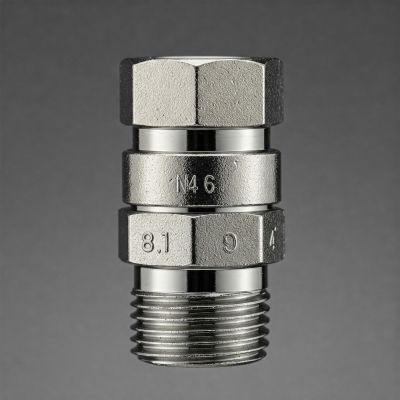Pipe threads play a crucial role in industrial applications, ensuring secure connections in piping and fluid systems. Among the various thread types, the National Pipe Taper Fuel (NPTF) thread stands out due to its ability to form a leak-free seal without the use of additional sealing compounds. Understanding NPTF threads is essential for professionals working with hydraulic, pneumatic, and fuel systems.
This guide will explain what NPTF threads are, their benefits, how they compare to other thread types, and best practices for using them effectively.
Understanding NPTF Thread
NPTF threads, also known as Dryseal Pipe Threads, are designed to create a mechanical seal by forming a tight metal-to-metal connection. Unlike standard pipe threads that require sealants to prevent leaks, NPTF threads achieve a secure, leak-proof seal through precise thread deformation.
Key Features of NPTF Threads
➡️ Tapered design for secure sealing without sealant.
➡️ Thread deformation ensures a leak-free connection.
➡️ Used in high-pressure and fuel system applications.
➡️ Complies with ANSI/ASME B1.20.3 standards.
Common Industries and Applications
➡️ Hydraulic and pneumatic systems
➡️ Automotive fuel lines
➡️ Industrial machinery and equipment
➡️ Gas and fluid transfer systems
How NPTF Threads Work
NPTF threads create a mechanical seal by tightly compressing the mating threads. The male and female threads deform slightly upon engagement, filling any potential gaps and ensuring a dry-seal connection. This differs from standard tapered threads, which often require Teflon tape or pipe dope to prevent leaks.
Difference Between a Dry-Seal Thread and Standard Tapered Threads
➡️ NPTF (Dry-Seal Thread): Forms a leak-proof seal through thread deformation.
➡️ NPT (Standard Tapered Thread): Requires thread sealant to prevent leaks.
The Role of Thread Deformation in Sealing
When an NPTF fitting is tightened, the crest and root of the threads compress against each other, eliminating any voids where fluid or gas could escape. This mechanical interference enhances the reliability of the connection, making it ideal for high-pressure systems.
NPTF vs. NPT: What’s the Difference?
Taper and Seal Differences
➡️ NPTF: Creates a dry seal through mechanical deformation.
➡️ NPT: Additional sealant is required to ensure a leak-free connection.
Applications: When to Use NPTF Over NPT
➡️ Use NPTF: When a secure, leak-proof seal is required without sealant.
➡️ Use NPT: When working with lower pressure applications that allow for thread sealant use.
Interchangeability: Can NPTF and NPT Threads Be Used Together?
While NPTF and NPT threads have similar taper angles, they are not fully interchangeable. NPT threads may not create a complete dry seal when used with NPTF counterparts, potentially leading to leaks in high-pressure applications.
NPTF Thread Standards and Specifications
The ANSI/ASME B1.20.3 standard defines the tolerances and specifications for NPTF threads, ensuring consistent performance across different applications.
Key Tolerances and Requirements
➡️ Specific pitch diameters and taper angles.
➡️ Controlled thread deformation for leak-proof sealing.
➡️ Manufacturing precision to ensure compatibility.
How to Verify NPTF Thread Specifications
➡️ Use thread gauges to confirm compliance.
➡️ Cross-reference with ANSI/ASME standards.
➡️ Conduct pressure testing in critical applications.
How to Identify NPTF Threads
Visual Differences Between NPTF and Other Thread Types
➡️ NPTF threads have a more precise fit than standard NPT.
➡️ The threads appear sharper and more tightly engaged.
Tools Used for Measuring and Identifying NPTF Threads
➡️ Thread pitch gauges.
➡️ Optical comparators.
➡️ Precision measuring instruments for diameter verification.
Common Mistakes in Thread Identification
➡️ Confusing NPTF with NPT due to their similar appearance.
➡️ Using improper measuring tools.
➡️ Assuming a thread is NPTF without proper verification.
Benefits of Using NPTF Threads
➡️ Leak-Free Connection: Eliminates the need for thread sealant.
➡️ High-Pressure Suitability: Ideal for demanding applications.
➡️ Increased Reliability: Reduces maintenance needs and improves system integrity.
Common Applications of NPTF Threads
Hydraulic and Pneumatic Systems
NPTF threads are widely used in hydraulic and pneumatic systems where a secure, leak-proof connection is essential for operational efficiency.
Fuel Lines and Automotive Applications
Automobile manufacturers and fuel system engineers prefer NPTF threads due to their ability to withstand high pressure without additional sealants.
Industrial Machinery and Manufacturing
NPTF fittings are commonly found in industrial equipment that transports fluids or gases under high pressure.
Best Practices for Working with NPTF Threads
Proper Installation Techniques for a Secure Seal
➡️ Ensure threads are clean and free from debris.
➡️ Use proper torque levels to achieve a secure fit.
➡️ Avoid over-tightening, which can damage the threads.
Tools and Equipment Needed for NPTF Threading
➡️ Threading dies and taps.
➡️ Thread gauges for measurement.
➡️ Proper wrenches for secure installation.
Avoiding Common Installation Errors
➡️ Not verifying thread type before installation.
➡️ Over-reliance on sealants when not necessary.
➡️ Improper engagement leads to leaks.
Conclusion
For professionals working in industries requiring high-pressure, leak-proof connections, NPTF threads provide a reliable and efficient solution. Ensuring proper installation and adherence to standards will maximize the benefits of using NPTF threads in various applications.
Summary of Key Points
➡️ NPTF threads provide a secure, leak-proof connection without the need for sealants.
➡️ They work by thread deformation, ensuring a dry-seal fit.
➡️ Used in high-pressure applications such as fuel systems, hydraulics, and industrial machinery.
➡️ Proper identification, installation, and adherence to standards ensure optimal performance.
Selecting the correct thread type is crucial for system reliability and safety. NPTF threads offer an advantage in applications where leaks cannot be tolerated.
Post time: Feb-27-2025


